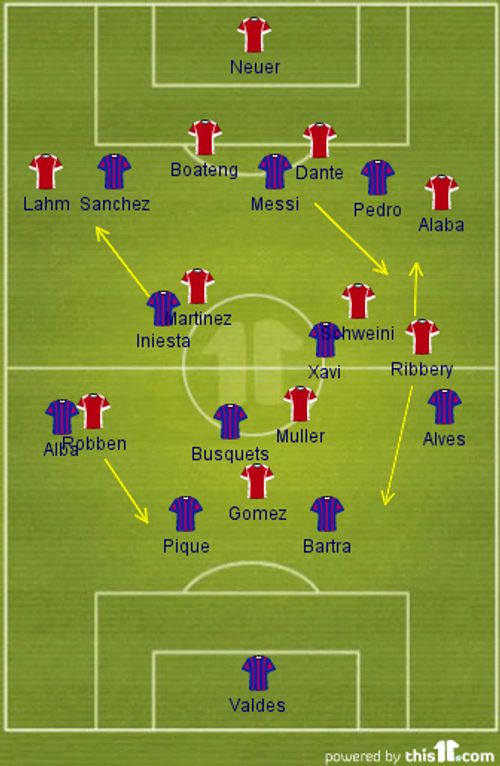
Bayern Munich 4-0 Barcelona: Dominant Bayern defeat Barcelona

Bayern Munich produced a stunning performance to defeat Barcelona in the first leg of Champions league semifinals convincingly.
Jupp Heynckes was without suspended Mario Mandzukic and the injured Toni Kroos. He had an option of selecting Mario Gomez or Claudio Pizarro and went with the former although both scored a brace on the weekend. Muller played Kroos’s role behind Gomez with Robben coming into the starting 11. Tito Vilanova was without Puyol and Mascherano so Bartra played as central defender alongside Pique. Upfront, he opted for Pedro and Sanchez’s pace to exploit the space behind Alaba and Lahm instead of using David Villa.
This was a match between the two best passing teams in Europe who play with high pressing from the back, and the pre-match talk was about the clash of the midfield trios. Bayern let Barca have the ball in this region but won the match.
Midfield Battle

Despite being similar in passing and pressing game, Bayern and Barca play with different shape. Barca play a 4-3-3 with one holder and two creative midfielders in Xavi and Iniesta, and Bayern play a 4-2-3-1 with Muller playing in the “hole” and Schweinsteiger and Javi Martinez in the double pivot. On paper at least, Busquets picks up Muller, leaving Iniesta vs Martinez and possession recyclers – Schweinsteiger vs Xavi.
Bayern took a reactive approach here and let Barcelona have the ball in this region but pressed aggressively and hit them on the counter. Their midfield trio was also very functional and each player had different responsibilities. Martinez pressed Iniesta aggressively and restricted him from going forward. Muller, on the other hand, despite being a naturally hard working player, did not make a single tackle in the entire game. He played relatively higher – almost as a second forward – when Barca had the ball, compensating for Gomez’s pressing (or lack of). His role was to occupy Busquets, not allowing him to start attacks and break forward on counter once Bayern win the ball. Schweinsteiger played his usual role as possession “recycler” to perfection. His energy was crucial in both attacking and defensive phases of the game as he often provided an outlet for pass.
Messi

With both sets of midfielders cancelling out each other, it looked like Messi would drop deep into the midfield areas to create a 4v3 numerical advantage as well as provide verticality to their build-up play. Here’s where Barcelona had problems. Messi was declared fit in the last minute and for most part of the match he looked sluggish. He started in his usual central position and was frustrated by a lack of service from midfield area since Bayern shut down the passing lanes. He started dropping deep as a result and rarely provided the verticality Barca desperately needed. He wasn’t willing to take on players and his passes were surprisingly lacking in ambition (Only 19 out of 57 passes were forward. The rest were either backward or sideways). This is acceptable when he plays in central areas with his back to the goal, but here he was playing deep. It’s debatable as to whether Cesc Fabregas would have done a better job than half fit Messi, which could have also given Barca the option of introducing Messi as impact sub. Whether the outcome of the match would have changed if Cesc played instead is debatable, but he’d have certainly provided more energy and verticality to Barca’s play.
Substitutions
At 2-0, Heynckes shut the shop and took Gomez off for the defensive Luis Gustavo with Muller and Schweinsteiger playing upfront. The game became more stretched as Barca had to get an away goal but Tito Vilanova’s reluctance to make changes was hugely surprising. Barca were looking tired and predictable and Bayern scored two goals with some slick movement to seal the tie. When Vilanova made one change in 83rd minute, Pedro off for David Villa, it was too late for Barca. Fabregas was left as unused sub.
Conclusion
Barcelona’s Champions League campaign this season was underwhelming in many ways and showed their mortal side, in a way, but this kind of drubbing was not expected. At the start of the season, there was a question posed if Barca were becoming too reliant on Messi. While the second leg impact substitution against PSG proved it right and probably in a good light, this match proved it again but not in a way Barca would prefer.
While the overall pressing level and intensity has dropped under Tito Vilanova, it reduced the mental fatigue and can’t be entirely pointed at this defeat. Messi on the other hand probably shouldn’t have started the match. Ironically though, all of Bayern’s goals came from either set plays or counter attacks, which are Barcelona’s main and obvious weaknesses. Bayern stopped Barcelona from playing their game and exploited their weaknesses. This is not to say Bayern didn’t match Barca in the midfield, but the strategy is similar to what Milan did in the 1st leg, Real Madrid did in the Copa del Rey and PSG in Champions League quarters. Teams seem to have worked out Barcelona by letting them have possession and closing the midfield passing lanes to Messi and exploiting the set plays and counter attacks. Barca survived the ties against Milan and PSG, but against the likes of Bayern, they came second best.